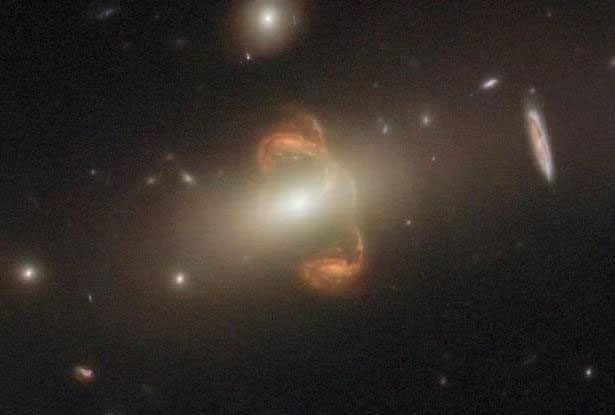One of the two identical galaxies you see in Hubble’s images is a ghost, literally!
In addition to the newly operational James Webb Space Telescope, NASA also operates another super telescope in collaboration with the European Space Agency (ESA), a powerful warrior that has brought back unique images, including the recently announced “galaxy mirror”.
According to Science Alert, Hubble’s images show two identical galaxies, bright orange in color, connected by long strands of light. However, only one is real. The other one you are seeing is a ghost.

The unique image features an orange galaxy and its symmetrical ghost, with the “galaxy mirror” in the center, all three being “translucent” objects – (Photo: HUBBLE/NASA/ESA)
Named SGAS J143845+145407, this mysterious galaxy has teamed up with a phantom galaxy cluster to create a beautiful yet terrifying “galaxy mirror”: The gravitational force is so immense that it distorts space, creating a duplicate image of SGAS J143845+145407 on the other side of the galaxy cluster.
From Earth’s perspective, SGAS J143845+145407 is located behind the aforementioned galaxy cluster. SGAS J143845+145407 is 6.9 billion light-years away from Earth, while the galaxy cluster, acting as a mirror, is in front of it, 2.8 billion light-years away from us.
This also means that thanks to Hubble, we have seen three “translucent” objects: the orange galaxy, its ghost, and the “galaxy mirror.” All are images from billions of years ago, as light takes that long to reach Earth, which is why humanity is only now witnessing them.
This is a fascinating discovery. First of all, SGAS J143845+145407 is an infrared-bright galaxy, indicating that it is in a high star formation phase, and studying the star formation process will provide valuable pieces to gradually complete the cosmic history puzzle.
The galaxy mirror, acting as a gravitational lens, makes this discovery even more precious. This miraculous lens and the symmetrical image it creates can help scientists view star formation in the actual galaxy from a different, accurately recreated perspective.


















































